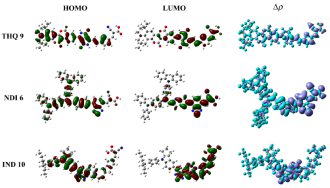 In silico designing of power conversion efficient organic lead dyes for solar cells using todays innovative approaches to assure renewable energy for future (太阳能电池中高转换效率有机铅染料:基于当前计算模拟的创新设计、确保未来的可再生能源)
In silico designing of power conversion efficient organic lead dyes for solar cells using todays innovative approaches to assure renewable energy for future (太阳能电池中高转换效率有机铅染料:基于当前计算模拟的创新设计、确保未来的可再生能源)
Supratik Kar, Juganta K. Roy & Jerzy Leszczynski
npj Computational Materials 3, Article number: 21 (2017)
doi:10.1038/s41524-017-0023-1
Published online:24 May 2017
Abstract| Full Text | PDF OPEN
摘要: 设计新型有机染料敏化剂并用于高转换效率的染料敏化太阳能电池可推动太阳能电池技术的进步,以避开硅基太阳能电池的诸多缺点。计算模拟研究包括定量构-性关系分析及量子化学分析可洞察碘电解质(11个不同化学族群中273个芳基胺有机染料)的主要电子转移机理和光物理特性。直接定量构-性关系模型能够识别化学分子的基本电子属性和结构属性,为11类芳胺有机染料分子性能的量化提供必要的前提条件,是筛选出染料敏化太阳能电池的高转换效率染料分子的基础。探索采用四氢喹啉,N,N'-二烷基苯胺和二氢吲哚作为芳基胺有机染料用于染料敏化太阳能电池的研究却鲜见报道。因此,本研究在“铅染料”设计中采用了上述类别的相应定量构-性关系模型对染料性质进行计算识别。然后对设计的染料的一系列电化学和光物理参数作了计算预测,以确定染料敏化太阳能电池中所需要的电子流动参量。最终通过组合计算技术给出了7种有前途的铅染料,分别用于所考察的所有三类分子(四氢喹啉,N,N'-二烷基苯胺和二氢吲哚)。与现有染料的最高实验转换效率相比,这三类染料的最高预测转换效率值(%,experimental %power conversion efficiency value)分别增加了130%,183%和46%,可满足所需的电化学参数。
Abstract: Advances in solar cell technology require designing of new organic dye sensitizers for dye-sensitized solar cells with high power conversion efficiency to circumvent the disadvantages of silicon-based solar cells. In silico studies including quantitative structure-property relationship analysis combined with quantum chemical analysis were employed to understand the primary electron transfer mechanism and photo-physical properties of 273 arylamine organic dyes from 11 diverse chemical families explicit to iodine electrolyte. The direct quantitative structure-property relationship models enable identification of the essential electronic and structural attributes necessary for quantifying the molecular prerequisites of 11 classes of arylamine organic dyes, responsible for high power conversion efficiency of dye-sensitized solar cells. Tetrahydroquinoline, N,N′-dialkylaniline and indoline have been least explored classes under arylamine organic dyes for dye-sensitized solar cells. Therefore, the identified properties from the corresponding quantitative structure-property relationship models of the mentioned classes were employed in designing of “lead dyes”. Followed by, a series of electrochemical and photo-physical parameters were computed for designed dyes to check the required variables for electron flow of dye-sensitized solar cells. The combined computational techniques yielded seven promising lead dyes each for all three chemical classes considered. Significant (130, 183, and 46%) increment in predicted %power conversion efficiency was observed comparing with the existing dye with highest experimental %power conversion efficiency value for tetrahydroquinoline, N,N′-dialkylaniline and indoline, respectively maintaining required electrochemical parameters.
Editorial Summary
Photovoltaics: computers help design efficient solar cells (光伏电池:电脑帮助设计高效的太阳能电池)
本研究定量设计了21种有望用于太阳能电池的染料,避免了冗长的帅选实验研究。来自西班牙杰克逊州立大学的Jerzy Leszczynski及其团队研究了11个化学分子家族中的数百种有机染料,将计算结果与实验数据相比较,确定了能提高太阳能电池效率的最重要的分子特性。以这些重要的分子特性作为准则,可设计一系列新型染料。其光学和电化学性质的计算模拟可使筛选的范围缩小。最后,他们预测了这些分子在染料敏化太阳能电池中的性能。采用组合计算技术他们确定了二十多种有前景的染料,能让实验科学家更快地合成和测试用所组装的太阳能电池。该方法还有助于设计更多其他化学家族中的分子用作太阳能电池染料。
Twenty-one promising dyes for solar cells are designed numerically, avoiding lengthy screening experiments. A team led by Jerzy Leszczynski at the Jackson State University studied a collection of hundreds of organic dyes, in eleven chemical families, compared computational results to experimental data, and identified the most important molecular properties that lead to high solar cell efficiency. Using these important molecular properties as guidelines, a series of new dyes were designed. Simulations of their optical and electrochemical properties allowed narrowing down the selection. Finally, their performance in dye-sensitized solar cells was predicted. Using combined computational techniques, the researchers identified two dozen promising dyes for experimentalists to synthesize and to test solar cells more rapidly. The methodology may help design more molecules in other chemical families.


 沪公网安备 31010502006565号
沪公网安备 31010502006565号